Genetics Report: DNA Replication, Mitosis, Meiosis and Analysis
VerifiedAdded on 2020/10/04
|6
|707
|255
Report
AI Summary
This report provides an overview of key concepts in genetics, starting with the structure of DNA, genes, and chromosomes, followed by the mechanism and importance of DNA replication. It then delves into cell division, contrasting mitosis and meiosis, and comparing their respective products. The report explains DNA replication as a process involving several steps, from replication fork formation to the final production of two DNA molecules, each with one parent strand and one new strand. Mitosis is presented as a process that results in two genetically identical daughter cells, while meiosis is described as a process that reduces the chromosome number by half, leading to genetically different haploid cells. The report concludes by comparing the products of mitosis and meiosis. The report also includes references to relevant books and journals.
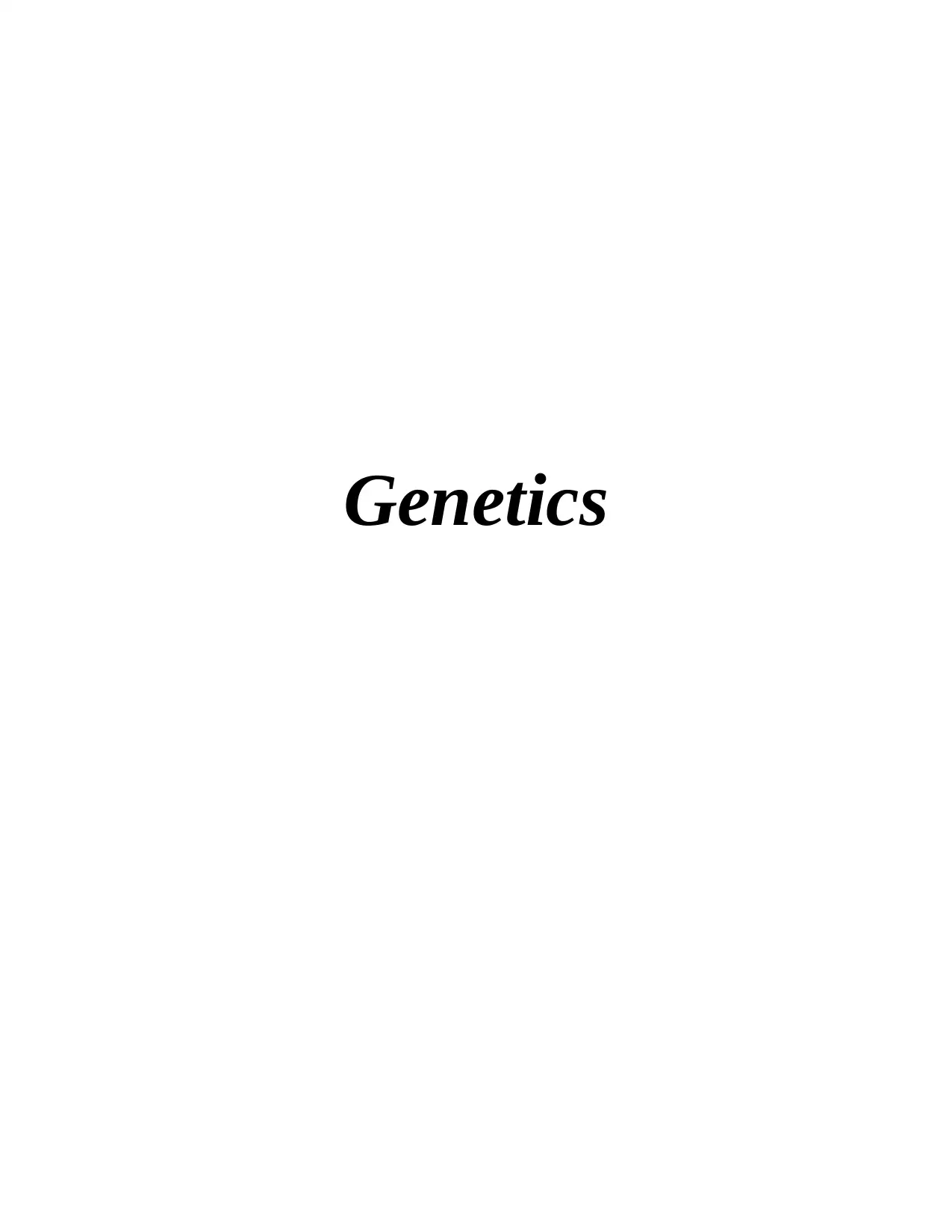
Genetics
Paraphrase This Document
Need a fresh take? Get an instant paraphrase of this document with our AI Paraphraser
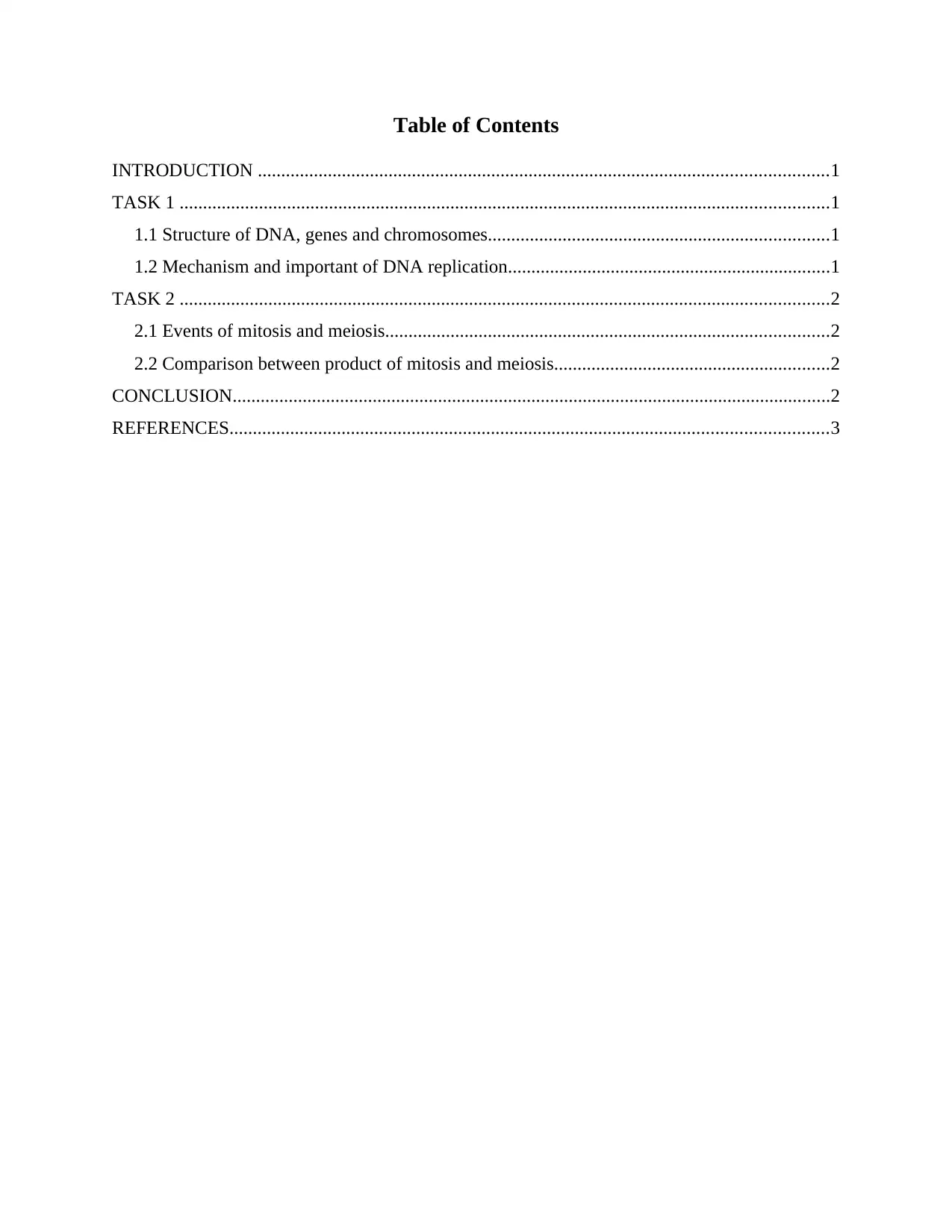
Table of Contents
INTRODUCTION ..........................................................................................................................1
TASK 1 ...........................................................................................................................................1
1.1 Structure of DNA, genes and chromosomes.........................................................................1
1.2 Mechanism and important of DNA replication.....................................................................1
TASK 2 ...........................................................................................................................................2
2.1 Events of mitosis and meiosis...............................................................................................2
2.2 Comparison between product of mitosis and meiosis...........................................................2
CONCLUSION................................................................................................................................2
REFERENCES................................................................................................................................3
INTRODUCTION ..........................................................................................................................1
TASK 1 ...........................................................................................................................................1
1.1 Structure of DNA, genes and chromosomes.........................................................................1
1.2 Mechanism and important of DNA replication.....................................................................1
TASK 2 ...........................................................................................................................................2
2.1 Events of mitosis and meiosis...............................................................................................2
2.2 Comparison between product of mitosis and meiosis...........................................................2
CONCLUSION................................................................................................................................2
REFERENCES................................................................................................................................3

⊘ This is a preview!⊘
Do you want full access?
Subscribe today to unlock all pages.

Trusted by 1+ million students worldwide
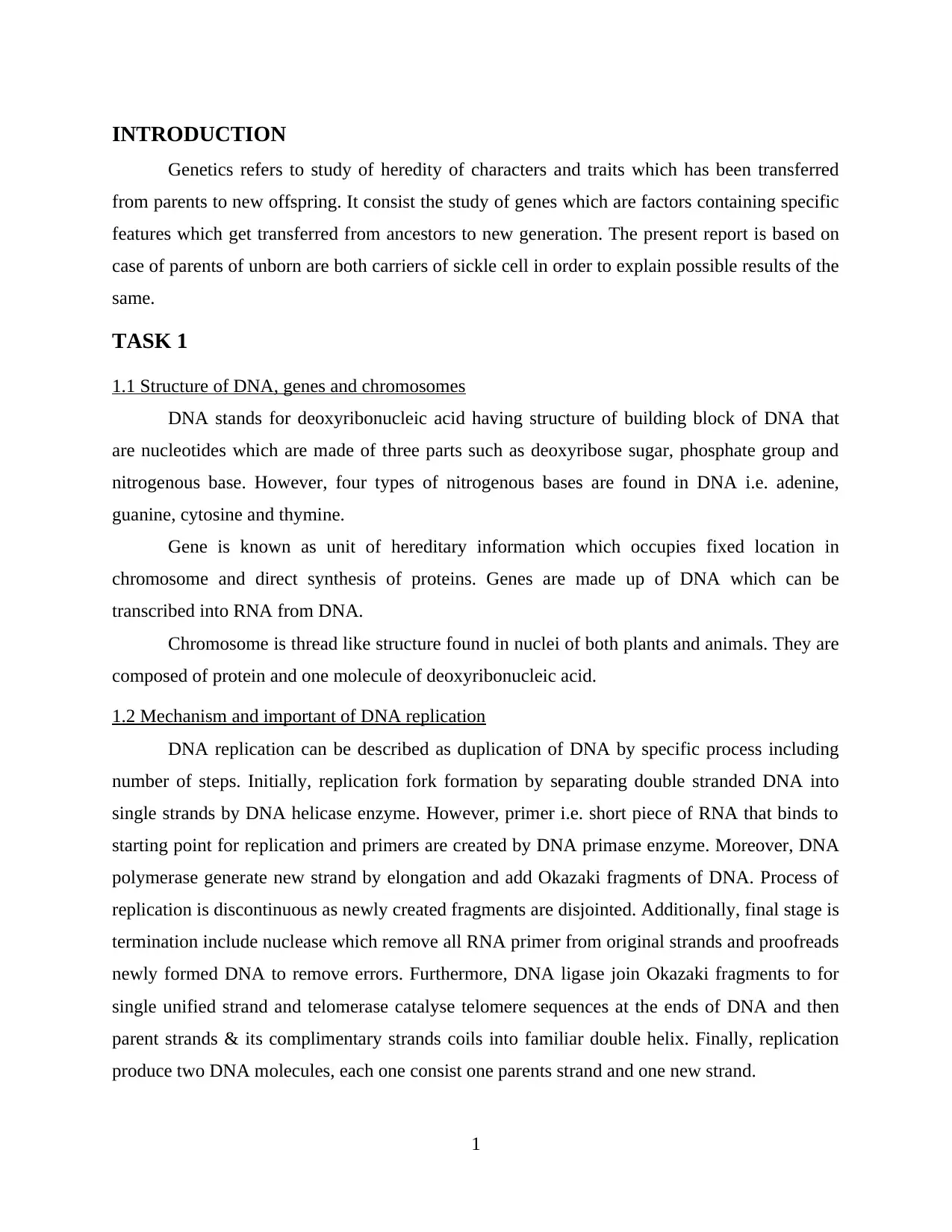
INTRODUCTION
Genetics refers to study of heredity of characters and traits which has been transferred
from parents to new offspring. It consist the study of genes which are factors containing specific
features which get transferred from ancestors to new generation. The present report is based on
case of parents of unborn are both carriers of sickle cell in order to explain possible results of the
same.
TASK 1
1.1 Structure of DNA, genes and chromosomes
DNA stands for deoxyribonucleic acid having structure of building block of DNA that
are nucleotides which are made of three parts such as deoxyribose sugar, phosphate group and
nitrogenous base. However, four types of nitrogenous bases are found in DNA i.e. adenine,
guanine, cytosine and thymine.
Gene is known as unit of hereditary information which occupies fixed location in
chromosome and direct synthesis of proteins. Genes are made up of DNA which can be
transcribed into RNA from DNA.
Chromosome is thread like structure found in nuclei of both plants and animals. They are
composed of protein and one molecule of deoxyribonucleic acid.
1.2 Mechanism and important of DNA replication
DNA replication can be described as duplication of DNA by specific process including
number of steps. Initially, replication fork formation by separating double stranded DNA into
single strands by DNA helicase enzyme. However, primer i.e. short piece of RNA that binds to
starting point for replication and primers are created by DNA primase enzyme. Moreover, DNA
polymerase generate new strand by elongation and add Okazaki fragments of DNA. Process of
replication is discontinuous as newly created fragments are disjointed. Additionally, final stage is
termination include nuclease which remove all RNA primer from original strands and proofreads
newly formed DNA to remove errors. Furthermore, DNA ligase join Okazaki fragments to for
single unified strand and telomerase catalyse telomere sequences at the ends of DNA and then
parent strands & its complimentary strands coils into familiar double helix. Finally, replication
produce two DNA molecules, each one consist one parents strand and one new strand.
1
Genetics refers to study of heredity of characters and traits which has been transferred
from parents to new offspring. It consist the study of genes which are factors containing specific
features which get transferred from ancestors to new generation. The present report is based on
case of parents of unborn are both carriers of sickle cell in order to explain possible results of the
same.
TASK 1
1.1 Structure of DNA, genes and chromosomes
DNA stands for deoxyribonucleic acid having structure of building block of DNA that
are nucleotides which are made of three parts such as deoxyribose sugar, phosphate group and
nitrogenous base. However, four types of nitrogenous bases are found in DNA i.e. adenine,
guanine, cytosine and thymine.
Gene is known as unit of hereditary information which occupies fixed location in
chromosome and direct synthesis of proteins. Genes are made up of DNA which can be
transcribed into RNA from DNA.
Chromosome is thread like structure found in nuclei of both plants and animals. They are
composed of protein and one molecule of deoxyribonucleic acid.
1.2 Mechanism and important of DNA replication
DNA replication can be described as duplication of DNA by specific process including
number of steps. Initially, replication fork formation by separating double stranded DNA into
single strands by DNA helicase enzyme. However, primer i.e. short piece of RNA that binds to
starting point for replication and primers are created by DNA primase enzyme. Moreover, DNA
polymerase generate new strand by elongation and add Okazaki fragments of DNA. Process of
replication is discontinuous as newly created fragments are disjointed. Additionally, final stage is
termination include nuclease which remove all RNA primer from original strands and proofreads
newly formed DNA to remove errors. Furthermore, DNA ligase join Okazaki fragments to for
single unified strand and telomerase catalyse telomere sequences at the ends of DNA and then
parent strands & its complimentary strands coils into familiar double helix. Finally, replication
produce two DNA molecules, each one consist one parents strand and one new strand.
1
Paraphrase This Document
Need a fresh take? Get an instant paraphrase of this document with our AI Paraphraser
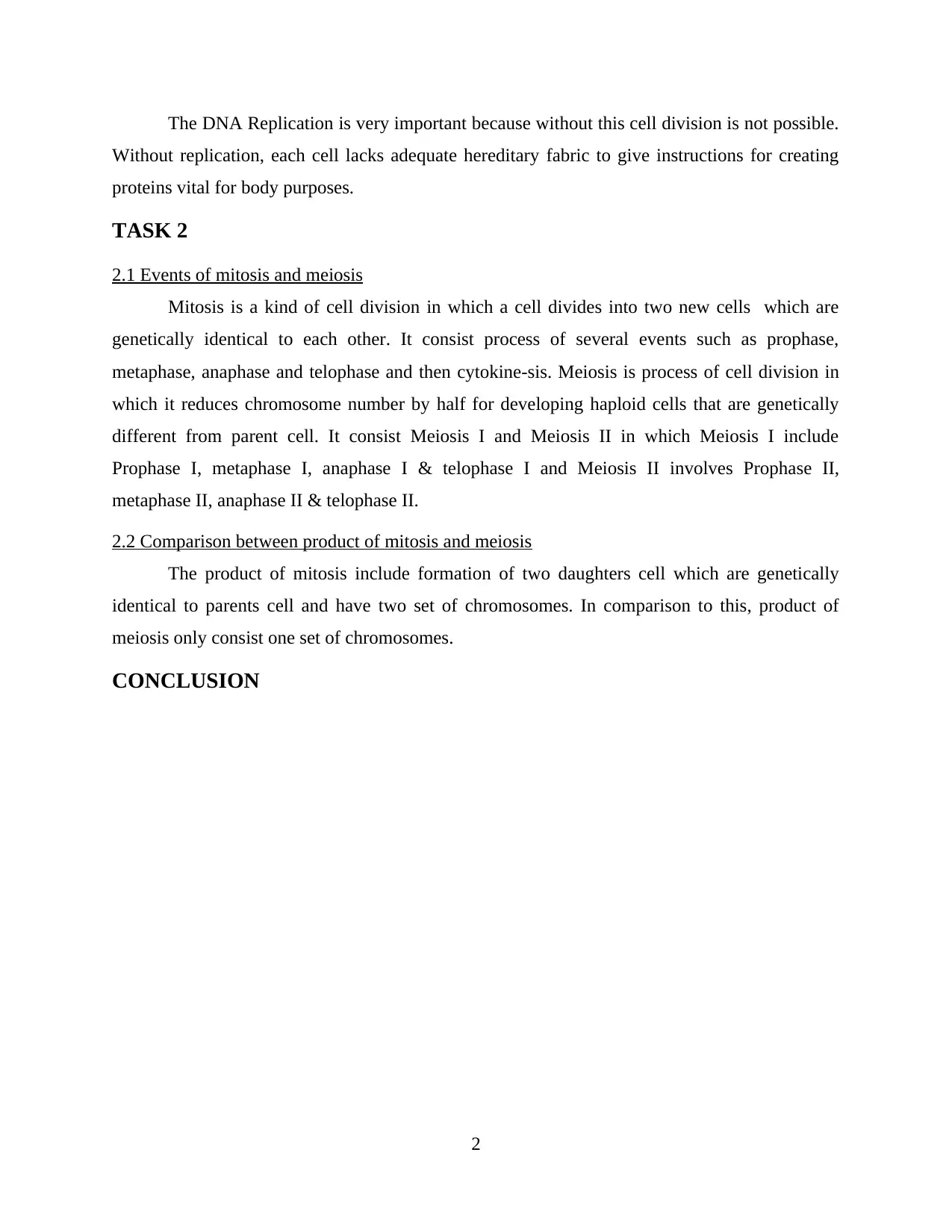
The DNA Replication is very important because without this cell division is not possible.
Without replication, each cell lacks adequate hereditary fabric to give instructions for creating
proteins vital for body purposes.
TASK 2
2.1 Events of mitosis and meiosis
Mitosis is a kind of cell division in which a cell divides into two new cells which are
genetically identical to each other. It consist process of several events such as prophase,
metaphase, anaphase and telophase and then cytokine-sis. Meiosis is process of cell division in
which it reduces chromosome number by half for developing haploid cells that are genetically
different from parent cell. It consist Meiosis I and Meiosis II in which Meiosis I include
Prophase I, metaphase I, anaphase I & telophase I and Meiosis II involves Prophase II,
metaphase II, anaphase II & telophase II.
2.2 Comparison between product of mitosis and meiosis
The product of mitosis include formation of two daughters cell which are genetically
identical to parents cell and have two set of chromosomes. In comparison to this, product of
meiosis only consist one set of chromosomes.
CONCLUSION
2
Without replication, each cell lacks adequate hereditary fabric to give instructions for creating
proteins vital for body purposes.
TASK 2
2.1 Events of mitosis and meiosis
Mitosis is a kind of cell division in which a cell divides into two new cells which are
genetically identical to each other. It consist process of several events such as prophase,
metaphase, anaphase and telophase and then cytokine-sis. Meiosis is process of cell division in
which it reduces chromosome number by half for developing haploid cells that are genetically
different from parent cell. It consist Meiosis I and Meiosis II in which Meiosis I include
Prophase I, metaphase I, anaphase I & telophase I and Meiosis II involves Prophase II,
metaphase II, anaphase II & telophase II.
2.2 Comparison between product of mitosis and meiosis
The product of mitosis include formation of two daughters cell which are genetically
identical to parents cell and have two set of chromosomes. In comparison to this, product of
meiosis only consist one set of chromosomes.
CONCLUSION
2
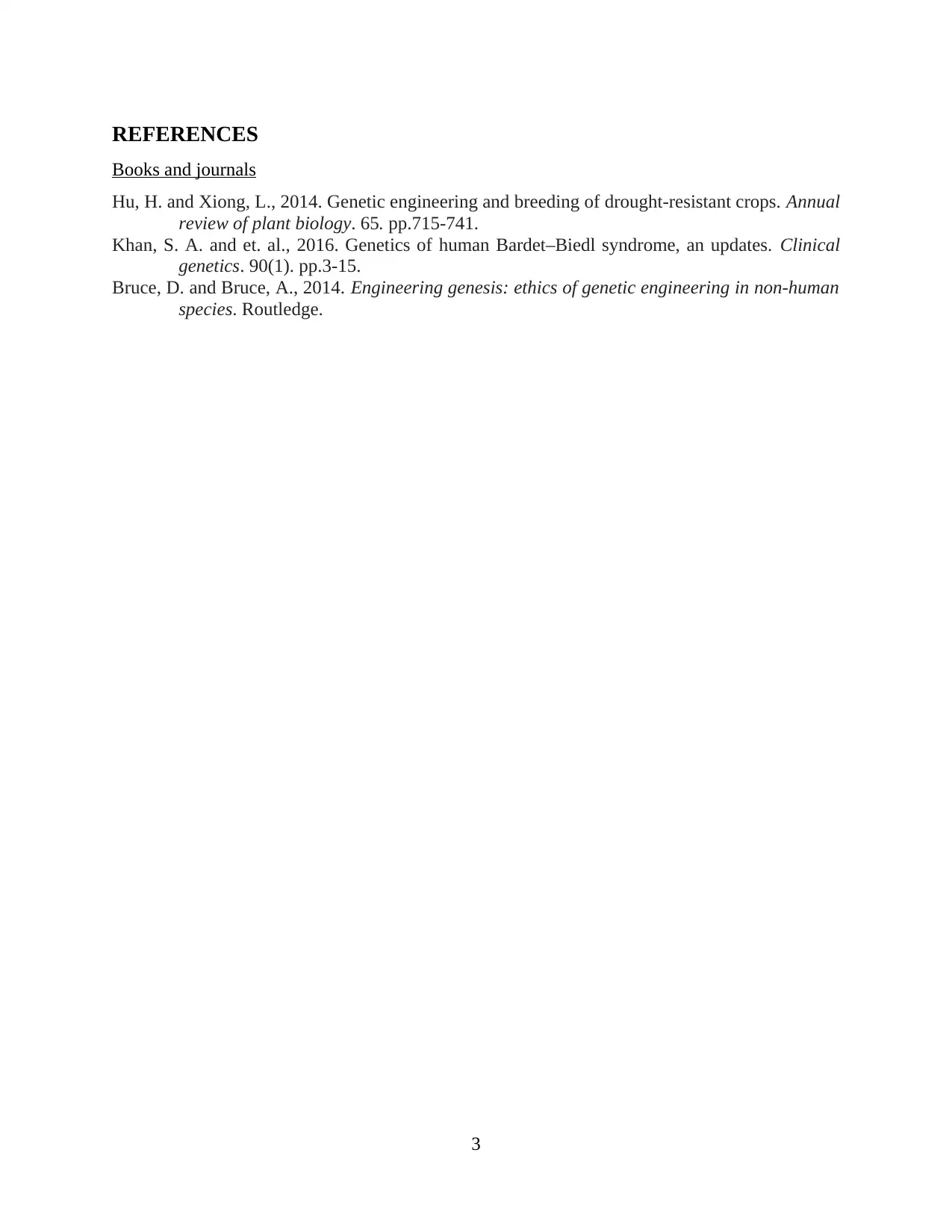
REFERENCES
Books and journals
Hu, H. and Xiong, L., 2014. Genetic engineering and breeding of drought-resistant crops. Annual
review of plant biology. 65. pp.715-741.
Khan, S. A. and et. al., 2016. Genetics of human Bardet–Biedl syndrome, an updates. Clinical
genetics. 90(1). pp.3-15.
Bruce, D. and Bruce, A., 2014. Engineering genesis: ethics of genetic engineering in non-human
species. Routledge.
3
Books and journals
Hu, H. and Xiong, L., 2014. Genetic engineering and breeding of drought-resistant crops. Annual
review of plant biology. 65. pp.715-741.
Khan, S. A. and et. al., 2016. Genetics of human Bardet–Biedl syndrome, an updates. Clinical
genetics. 90(1). pp.3-15.
Bruce, D. and Bruce, A., 2014. Engineering genesis: ethics of genetic engineering in non-human
species. Routledge.
3
⊘ This is a preview!⊘
Do you want full access?
Subscribe today to unlock all pages.

Trusted by 1+ million students worldwide
1 out of 6
Related Documents
Your All-in-One AI-Powered Toolkit for Academic Success.
+13062052269
info@desklib.com
Available 24*7 on WhatsApp / Email
![[object Object]](/_next/static/media/star-bottom.7253800d.svg)
Unlock your academic potential
Copyright © 2020–2025 A2Z Services. All Rights Reserved. Developed and managed by ZUCOL.





